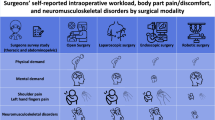Abstract
Background
Minimally invasive surgical techniques such as robotic surgical platforms have provided favourable outcomes for patients, but the impact on surgeons is not well described. This systematic review aims to synthesize and evaluate the physical and mental impact of robotic surgery on surgeons compared to standard laparoscopic or open surgery.
Methods
A search strategy was developed to identify peer-reviewed English articles published from inception to end of December 2019 on the following databases: MEDLINE, PubMed, PsycINFO and Embase. The articles were assessed using a modified Newcastle–Ottawa tool.
Results
Of the 6563 papers identified, 30 studies were included in the qualitative synthesis of this review. Most of the included studies presented a high risk of bias. A total of 13 and 21 different physical and mental tools, respectively, were used to examine the impact on surgeons. The most common tool used to measure physical and mental demand were surface electromyography (N = 9) and the NASA Task Load Index (NASA-TLX; N = 8), respectively. Majority of studies showed mixed results for physical (N = 10) and mental impact (N = 7). This was followed by eight and six studies favouring RS over other surgical modalities for physical and mental impact, respectively.
Conclusion
Most studies showed mixed physical and mental outcomes between the three surgical modalities. There was a high risk of bias and methodological heterogeneity. Future studies need to correlate mental and physical stress with long-term impact on the surgeons.

Similar content being viewed by others
References
Darzi A, Munz Y (2004) The impact of minimally invasive surgical techniques. Annu Rev Med 55:223–237
Wagenaar S, Nederhoed JH, Hoksbergen AWJ et al (2017) Minimally invasive, laparoscopic, and robotic-assisted techniques versus open techniques for kidney transplant recipients: a systematic review. Eur Urol 72:205–217
Gershman B, Bukavina L, Chen Z et al (2018) The association of robot-assisted versus pure laparoscopic radical nephrectomy with perioperative outcomes and hospital costs. Eur Urol Focus 6:305–312
Stefanidis D, Wang F, Korndorffer JR Jr et al (2010) Robotic assistance improves intracorporeal suturing performance and safety in the operating room while decreasing operator workload. Surg Endosc 24:377–382
Coughlin GD, Yaxley JW, Chambers SK et al (2018) Robot-assisted laparoscopic prostatectomy versus open radical retropubic prostatectomy: 24-month outcomes from a randomised controlled study. Lancet Oncol 19:1051–1060
Berguer R, Forkey DL, Smith WD (1999) Ergonomic problems associated with laparoscopic surgery. Surg Endosc 13:466–468
Lee GI, Lee MR, Clanton T et al (2014) Comparative assessment of physical and cognitive ergonomics associated with robotic and traditional laparoscopic surgeries. Surg Endosc 28:456–465
Dalsgaard T, Jensen MD, Hartwell D et al (2020) Robotic surgery is less physically demanding than laparoscopic surgery: paired cross sectional study. Ann Surg 271:106–113
Hislop J, Tirosh O, McCormick J et al (2019) Muscle activation during traditional laparoscopic surgery compared with robot-assisted laparoscopic surgery: a meta-analysis. Surg Endosc 03:03
Dalager T, Sogaard K, Bech KT et al (2017) Musculoskeletal pain among surgeons performing minimally invasive surgery: a systematic review. Surg Endosc 31:516–526
Abdelrahman AM, Lowndes B, Rand C et al (2017) Impact of robotic surgery versus laparoscopic surgery on surgeon musculoskeletal symptoms and workload: a systematic review and meta-analysis. Surg Endosc Other Interv Tech 31(1):S324
Shamseer L, Moher D, Clarke M et al (2015) Preferred reporting items for systematic review and meta-analysis protocols (PRISMA-P) 2015: elaboration and explanation. BMJ 350:g7647
Herzog R, Álvarez-Pasquin MJ, Díaz C et al (2013) Are healthcare workers’ intentions to vaccinate related to their knowledge, beliefs and attitudes? A systematic review. BMC Public Health 13:154
van der Schatte Olivier RH, Van’t Hullenaar CD, Ruurda JP et al (2009) Ergonomics, user comfort, and performance in standard and robot-assisted laparoscopic surgery. Surg Endosc 23:1365–1371
Hubert N, Gilles M, Desbrosses K et al (2013) Ergonomic assessment of the surgeon’s physical workload during standard and robotic assisted laparoscopic procedures. Int J Med Robot 9:142–147
Zihni AM, Ohu I, Cavallo JA et al (2014) Ergonomic analysis of robot-assisted and traditional laparoscopic procedures. Surg Endosc 28:3379–3384
Sanchez A, Rodriguez O, Jara G et al (2018) Robot-assisted surgery and incisional hernia: a comparative study of ergonomics in a training model. J Robot Surg 12:523–527
Stefanidis D, Hope WW, Scott DJ (2011) Robotic suturing on the FLS model possesses construct validity, is less physically demanding, and is favored by more surgeons compared with laparoscopy. Surg Endosc 25:2141–2146
Moss EL, Sarhanis P, Ind T et al (2019) Impact of obesity on surgeon ergonomics in robotic and straight-stick laparoscopic surgery. J Minim Invasive Gynecol. https://doi.org/10.1016/j.jmig.2019.07.009
Law KE, Lowndes BR, Kelley SR et al (2018) NASA-task load index differentiates surgical approach opportunities for improvement in colon and rectal surgery. Ann Surg. https://doi.org/10.1097/SLA.0000000000003173
Lee J, Kang SW, Jung JJ et al (2011) Multicenter study of robotic thyroidectomy: Short-term postoperative outcomes and surgeon ergonomic considerations. Ann Surg Oncol 18:2538–2547
Elhage O, Challacombe B, Shortland A et al (2015) An assessment of the physical impact of complex surgical tasks on surgeon errors and discomfort: a comparison between robot-assisted, laparoscopic and open approaches. BJU Int 115:274–281
Zihni AM, Ohu I, Cavallo JA et al (2014) FLS tasks can be used as an ergonomic discriminator between laparoscopic and robotic surgery. Surg Endosc 28:2459–2465
Lawson EH, Curet MJ, Sanchez BR et al (2007) Postural ergonomics during robotic and laparoscopic gastric bypass surgery: a pilot project. J Robot Surg 1:61–67
Szeto GP, Poon JT, Law WL (2013) A comparison of surgeon’s postural muscle activity during robotic-assisted and laparoscopic rectal surgery. J Robot Surg 7:305–308
Zarate Rodriguez JG, Zihni AM, Ohu I et al (2019) Ergonomic analysis of laparoscopic and robotic surgical task performance at various experience levels. Surg Endosc 33:1938–1943
Mendes V, Bruyere F, Escoffre JM et al (2019) Experience implication in subjective surgical ergonomics comparison between laparoscopic and robot-assisted surgeries. J Robot Surg. https://doi.org/10.1007/s11701-019-00933-2
Armijo PR, Huang CK, High R et al (2019) Ergonomics of minimally invasive surgery: an analysis of muscle effort and fatigue in the operating room between laparoscopic and robotic surgery. Surg Endosc 33:2323–2331
Van Koughnett JA, Jayaraman S, Eagleson R et al (2009) Are there advantages to robotic-assisted surgery over laparoscopy from the surgeon’s perspective? J Robot Surg 3:79–82
Tarr ME, Brancato SJ, Cunkelman JA et al (2015) Comparison of postural ergonomics between laparoscopic and robotic sacrocolpopexy: a pilot study. J Minim Invasive Gynecol 22:234–238
Marcon B, Sime WN, Guillemin F et al (2019) An ergonomic assessment of four different donor nephrectomy approaches for the surgeons and their assistants. Res Rep Urol 11:261–268
Butler KA, Kapetanakis VE, Smith BE et al (2013) Surgeon fatigue and postural stability: is robotic better than laparoscopic surgery? J Laparoendosc Adv Surg Tech A 23:343–346
Moore LJ, Wilson MR, Waine E et al (2015) Robotically assisted laparoscopy benefits surgical performance under stress. J Robot Surg 9:277–284
Collins SA, O’Sullivan DM, Tulikangas PK (2012) Surgeon activity in robotic versus abdominal gynecologic surgery. J Robot Surg 6:333–336
Gonzalez-Sanchez M, Gonzalez-Poveda I, Mera-Velasco S et al (2017) Comparison of fatigue accumulated during and after prolonged robotic and laparoscopic surgical methods: a cross-sectional study. Surg Endosc 31:1119–1135
Klein MI, Warm JS, Riley MA et al (2012) Mental workload and stress perceived by novice operators in the laparoscopic and robotic minimally invasive surgical interfaces. J Endourol 26:1089–1094
Moore LJ, Wilson MR, McGrath JS et al (2015) Surgeons’ display reduced mental effort and workload while performing robotically assisted surgical tasks, when compared to conventional laparoscopy. Surg Endosc 29:2553–2560
Hurley AM, Kennedy PJ, O’Connor L et al (2015) SOS save our surgeons: stress levels reduced by robotic surgery. Gynecol Surg 12:197–206
Passerotti CC, Franco F, Bissoli JC et al (2015) Comparison of the learning curves and frustration level in performing laparoscopic and robotic training skills by experts and novices. Int Urol Nephrol 47:1075–1084
Klein MI, Mouraviev V, Craig C et al (2014) Mental stress experienced by first-year residents and expert surgeons with robotic and laparoscopic surgery interfaces. J Robot Surg 8:149–155
Heemskerk J, Zandbergen HR, Keet SW et al (2014) Relax, it’s just laparoscopy! a prospective randomized trial on heart rate variability of the surgeon in robot-assisted versus conventional laparoscopic cholecystectomy. Dig Surg 31:225–232
Lowndes BR, Forsyth KL, Blocker RC et al (2020) NASA-TLX Assessment of surgeon workload variation across specialties. Ann Surg 271:686–692
Acknowledgements
We would like to thank the librarians at the University of Sydney for their time and assistance in the systematic literature search.
Funding
There are no sources of funding to declare for this current study.
Author information
Authors and Affiliations
Corresponding author
Additional information
Publisher's Note
Springer Nature remains neutral with regard to jurisdictional claims in published maps and institutional affiliations.
Supplementary Information
Below is the link to the electronic supplementary material.
Rights and permissions
About this article
Cite this article
Park, L.S., Pan, F., Steffens, D. et al. Are Surgeons Working Smarter or Harder? A Systematic Review Comparing the Physical and Mental Demands of Robotic and Laparoscopic or Open Surgery. World J Surg 45, 2066–2080 (2021). https://doi.org/10.1007/s00268-021-06055-x
Accepted:
Published:
Issue Date:
DOI: https://doi.org/10.1007/s00268-021-06055-x




